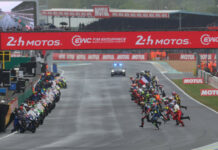The 2017 Suzuki GSX-R1000R intro video, promoting its IMU-based electronic traction control and cutback control systems, includes a brief segment showing how the mechanical, self-contained Suzuki Racing-Variable Valve Timing (SR-VVT) System works to increase top-end power without decreasing low-end and mid-range power.
The SR-VVT system was first used in MotoGP racing more than 10 years ago, and is now being used on a production machine for the first time. It uses centrifugal force and fits in the intake cam sprocket assembly, with steel balls positioned in curved grooves in the intake cam sprocket itself and straight grooves in an adjacent guide plate held in place by diaphragm springs and a spring clip. As rpm increases, the balls move outward, aligning the grooves and retarding the intake valve timing for better top-end power. In two of the accompanying photos, the guide plate has been replicated in plexiglass, so the balls can be seen in their low-rpm and high-rpm positions.
Because the system is self-contained inside the intake cam sprocket assembly and operates using centrifugal force (which is naturally generated any time the engine is running), it doesn’t use any engine power that could otherwise be used to turn the rear wheel, does not increase internal friction, and it doesn’t materially increase the weight or size of the engine.
During the time the system has been used in MotoGP competition, the riders have not been able to detect when it changes the valve timing. What they have been able to detect is an increase in top-end power with no loss of mid-range or low-end power, making the powerband stronger and more linear throughout the rev range.
Normally, valve timing is an either-or proposition: An engine’s cams can be timed to open and close the valves to increase low-end and mid-range power at the expense of top-end power, or to increase top-end power at the expense of low-end and mid-range power. The SR-VVT system allows the best of both worlds by automatically retarding the intake cam at higher rpm.






